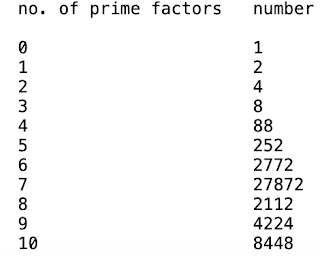Here is what Gemini had to say about the prime-producing polynomial \( 2 k^2+29\):
The polynomial \( 2 k^2+29\) is a well-known example of a prime-producing polynomial, often associated with the French mathematician Adrien-Marie Legendre. Here's a breakdown of its discovery, usage, and prime-producing potential:
Discovery:
Adrien-Marie Legendre (1752-1833) is credited with the discovery of the polynomial \( 2 k^2+29\). He published this result in his work "Essai sur la théorie des nombres" in 1798.
This came in the wake of significant work on prime-generating polynomials, notably Euler's polynomial \(k^2+k+41\), which generates primes for 40 consecutive integer values. Legendre's work further explored this fascinating property in different polynomial forms.
Usage and Significance:
Illustrates Prime-Generating Properties: While no non-constant polynomial with integer coefficients can generate only prime numbers for all integer values (this has been proven), polynomials like \( 2 k^2+29\) are significant because they produce a surprisingly long sequence of prime numbers for consecutive integer inputs.
Connection to Class Number Theory: The behavior of such prime-producing quadratic polynomials is deeply connected to the theory of class numbers in imaginary quadratic fields. The fact that \( 2 k^2+29\) (and other similar polynomials like Euler's \(k^2+k+41\)) produce so many primes is not a coincidence but is tied to specific properties of the corresponding quadratic fields.
Educational and Recreational Mathematics: These polynomials are frequently used in number theory courses and popular science to demonstrate the elusive nature of prime number distribution and the intriguing patterns that can emerge. They serve as excellent examples to explore the question of "prime-generating formulas."
In Popular Culture: The sequence of primes generated by \( 2 k^2+29\) has even appeared in popular culture, such as in Ken Follett's novel "Code to Zero."
Prime-Producing Potential:
The polynomial \( \text{P}(k)= 2 k^2+29 \) generates prime numbers for a remarkable number of consecutive integer values of \(k\). Specifically, it produces primes for \(k=0,1,2, \dots 28\). This means it generates 29 consecutive primes starting from .
Let's list the first few:
\( \text{P}(0)=2 \times 0^2+29=29 \) (prime)
\( \text{P}(1)=2 \times 1^2+29=31\) (prime)
\( \text{P}(2)=2 \times 2^2+29=37 \) (prime)
\( \text{P}(3)=2 \times 3^2+29=47 \) (prime)
...and so on, up to \( \text{P}(28) \).
For \(k=29\)$$\text{P}(29)=2 \times 29^2+29=29 \, (2×29+1)=29 \times 59$$which is a composite number. This illustrates the general principle that no such polynomial can produce primes indefinitely.
In summary, Legendre's polynomial \( 2 k^2+29\) is a notable discovery in number theory, demonstrating an impressive string of prime outputs for consecutive integer inputs. Its significance lies in its historical context alongside other prime-generating polynomials like Euler's, its connection to deeper number theoretic concepts like class numbers, and its role as a compelling example in the study of prime numbers.
The polynomial popped up because of a reference to it in OEIS A241554: composite numbers of the form \(2 k^2 + 29\). The number associated with my diurnal age today, 27877, is a member of this sequence:$$ \begin{align} \text{If }k &=118 \\ 2k^2+29 &= 2 \times 118^2+29 \\ &= 27877 \\ &=61 \times 457 \end{align}$$When this polynomial is not busy churning out primes, it is busy churning out semiprimes. In fact, it is only when \(k=185\) that we get a number that is not a prime or a semiprime:$$\begin{align} \text{If }k &=185 \\ 2k^2+29 &= 2 \times 185^2+29 \\ &= 68479 \\ &=31 \times 47^2 \end{align}$$Follow this permalink to generate a table of these numbers and their factors. Here is a list of the members of OEIS A241554 between 1 and 40000:
1711, 1829, 2077, 2479, 3071, 3901, 5029, 6527, 6757, 7471, 7967, 8479, 10397, 10981, 11581, 14141, 15167, 15517, 15871, 16591, 16957, 17701, 18079, 18847, 19631, 20837, 22927, 23791, 25567, 26941, 27877, 28829, 29797, 30287, 31279, 31781, 32287, 35941, 38117
The table below shows the factorisations of the previous numbers as well as the corresponding \(k\) values:
k 2*k^2+29 factors
29 1711 29 * 59
30 1829 31 * 59
32 2077 31 * 67
35 2479 37 * 67
39 3071 37 * 83
44 3901 47 * 83
50 5029 47 * 107
57 6527 61 * 107
58 6757 29 * 233
61 7471 31 * 241
63 7967 31 * 257
65 8479 61 * 139
72 10397 37 * 281
74 10981 79 * 139
76 11581 37 * 313
84 14141 79 * 179
87 15167 29 * 523
88 15517 59 * 263
89 15871 59 * 269
91 16591 47 * 353
92 16957 31 * 547
94 17701 31 * 571
95 18079 101 * 179
97 18847 47 * 401
99 19631 67 * 293
102 20837 67 * 311
107 22927 101 * 227
109 23791 37 * 643
113 25567 37 * 691
116 26941 29 * 929
118 27877 61 * 457
120 28829 127 * 227
122 29797 83 * 359
123 30287 31 * 977
125 31279 31 * 1009
126 31781 61 * 521
127 32287 83 * 389
134 35941 127 * 283
138 38117 47 * 811









